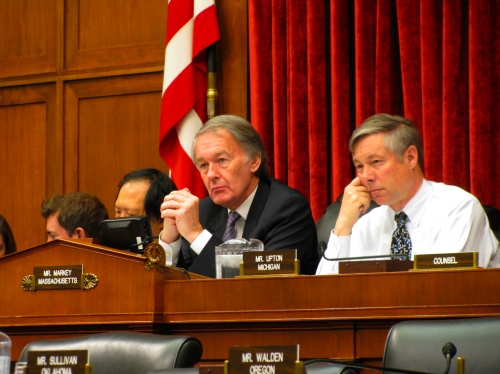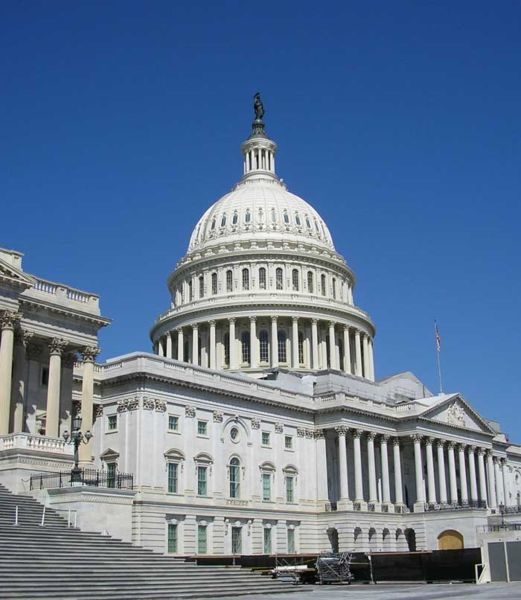The third day of climate hearings in the House made it clear that even representatives and interest groups that nominally support the principles of the Markey-Waxman bill have a laundry list of changes they’d like to see made to the bill before they’ll back it.
Thursday’s hearings brought 26 new witnesses before the Energy and Commerce Committee, each testifying to their specific concerns with the bill. The panels included representatives from unions, the coal industry, a chemical company, public utility commissions, manufacturers, the clergy, and environmental organizations. Many came with requests that would arguably weaken the bill — calling for free allocation of carbon credits, a safety valve that would kick in if the price of credits got too high, and more leniency for dirty coal plants.
 Their suggestions will be taken into account as legislators meet behind closed doors over the next few days to hash out the final provisions of the bill. The blank spaces in the current draft — how many carbon credits should be allocated freely versus auctioned off, what measures should be taken to insulate citizens and industries from higher energy costs — must be filled in before the committee can begin the markup process next week, during which lawmakers will offer and vote on amendments.
Their suggestions will be taken into account as legislators meet behind closed doors over the next few days to hash out the final provisions of the bill. The blank spaces in the current draft — how many carbon credits should be allocated freely versus auctioned off, what measures should be taken to insulate citizens and industries from higher energy costs — must be filled in before the committee can begin the markup process next week, during which lawmakers will offer and vote on amendments.
The bill’s sponsors are using these hearings to tease out the issues currently preventing fellow legislators and interested parties from wholeheartedly supporting the bill. “I can actually see some new working arrangements that could be constructed from your testimony to create a format we might be able to use,” Rep. Ed Markey (D-Mass.) told witnesses after the first panel on Thursday.
So what are you gonna do for me?
The question of how much the bill will cost average Americans has been the hottest topic during these first days of discussion.
“It’s all about the consumer,” Rep. Charles Gonzalez (D-Texas) told reporters. “Any increase in the price in energy looms large.” Gonzalez, a moderate who hasn’t fully backed the bill, will be one of several votes the bill’s sponsors are pursuing.
Republicans on the committee have painted a doomsday scenario of skyrocketing costs for American families, while the head of the EPA testified that her agency’s analysis of the bill found it would lead to only a modest increase in costs for most consumers. The key provisions that will determine the overall cost — how emission credits are distributed and how any revenues from that process are spent — have yet to be worked out, so everyone with a horse in the race is trying to influence the bill’s authors on these points.
The electric utility representatives testifying on Thursday argued that the best way to protect consumers is to give away all the carbon credits to polluters so they won’t raise prices. Most enviros take issue with that approach, as the whole point of a cap-and-trade plan is to create financial incentives for businesses to shift to cleaner fuels.
Jeff Sterba, representing the industry association Edison Electric Institute, told the committee that emission allowances to the electric sector “is the most effective way to minimize costs for customers.” He recommended that at least 40 percent of the total credits offered in a cap-and-trade program (equal to the amount of emissions the electricity generating industry is responsible for) be distributed free of cost, at least until the technologies for capturing and storing CO2 emissions from coal-fired plants is commercially available.
Glenn English, CEO of the National Rural Electric Cooperative Association, seconded the premise that the majority of credits should be allocated. He also called for a safety valve to be included in the bill, which would essentially halt the mechanisms of a cap-and-trade program should the price of carbon credits get too high. A safety valve, he said, “makes sure consumers are assured we have a limit on economic damage.”
Mark Crisson. the CEO of the American Public Power Association, joined the call for a safety valve and suggested that the committee remove from the bill a renewable electricity standard and tough emissions controls for new coal-fired power plants.
Another idea put forward was disbursing emission credits to local distribution companies (LDCs), rather than electric generators. Richard Morgan of the National Association of Regulatory Utility Commissioners, which represents state public service commissions, and Richard Cowart, director of the Regulatory Assistance Project, argued that LDCs would be better able to use the credits to protect consumers from price increases.
The future of coal-fired power was also a much-discussed topic, with panelists from the industry calling for major funding for carbon-capture-and-storage technologies. In that they were joined by Natural Resources Defense Council director of climate programs David Hawkins, one of the few voices representing the environmental community on Thursday. “I think we can get deep cuts faster and with lower costs if carbon capture is on the table,” said Hawkins.
And in case you haven’t heard enough already about what electricity companies want, John Somerhalder II, testifying on behalf of the American Gas Association, which represents natural gas utilities, argued that such facilities should be exempted from the plan entirely until 2016.
The lone panel member not calling for free allocation of emission credits was Robert Greenstein, executive director of the Center for Budget and Policy Priorities. His organization wants to see the vast majority of credits auctioned off, and the revenues from that auction returned to citizens through tax credits and other rebates. Routing consumer protections through electric utilities, he said, is “unwise,” as it cannot account for cost increases in other areas like gasoline and consumer goods. “Relief that only focuses on home electricity and gas bill leaves a major hole,” said Greenstein.
But he did suggest a middle-ground option: distributing a portion of credits to LDCs, and auctioning the rest to provide consumer refunds.
Jobs, jobs, jobs
The other main focus on Thursday was how to best prevent industries from fleeing the United States should a carbon pricing plan be enacted. Many members fear that jobs will leak out to other countries that don’t limit greenhouse-gas emissions, like China and India, and the U.S. will become less competitive in the international marketplace.
Republican committee members and their invited witnesses from conservative think tanks have claimed that the exit of energy-intensive industries would be inevitable under a cap-and-trade plan. Yet the majority of panelists argued that measures could be taken to prevent that outcome.
Tom Conway, international vice president of United Steel Workers, argued that the best solution would be to put a fee on energy-intensive products like steel that are coming in from other countries in order to bring the prices level with goods made in the U.S. under a carbon cap — at least until other countries enact their own emission-reduction plans. A so-called “border adjustment,” he argued, would keep the playing field fair for American manufacturers.
“Carbon shouldn’t be used at an advantage or disadvantage by any of these nations,” said Conway. “If we’re going to reach a global agreement on this, if someone’s not living up to it, there ought to be a penalty at a border as if it were done right … We believe that carbon reductions are the right thing, but it shouldn’t be done at the cost of jobs here.”
Others witnesses argued that free credit allocations to energy-intensive, trade-exposed industries could also help insulate them.
Ultimately, the goal is to get a global climate treaty that would bring countries like India and China under a carbon cap as well, as some panelists discussed. To do so, they argued, the United States must both take the lead at home and provide incentives for other countries to join in. Incentives should include aid for adaptation to a climate-changed world, reimbursement for avoided deforestation, and assistance in transitioning to clean energy, said witnesses from environmental and faith-based groups.
“Domestic action must provide positive incentives for the engagement of other countries,” said Eliot Diringer, vice president for international strategies at the Pew Center on Global Climate Change.
There’s still more where that came from
Friday is the last scheduled day of hearings on the draft bill, with several big names on the ticket. Al Gore will address the committee during the first panel of the day, along with former Sen. John Warner (R-Va.), who last year sponsored a Senate climate bill with Joe Lieberman (I-Conn.). The day’s second panel will feature the GOP’s go-to spokesperson, former House Speaker Newt Gingrich, champion of the “Drill here, drill now” slogan last summer.
Committee leaders still seem focused on getting the final language of the bill in place in the next few days, in order to begin markup next week. But a lot of grunt work will be needed between now and then to craft a bill that will satisfy a majority of the committee’s members.




